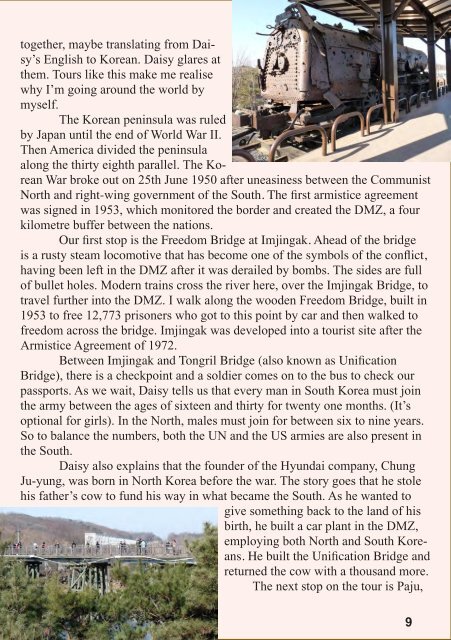Globe 2019 SUMMER
Globe 2019 SUMMER
Globe 2019 SUMMER
- TAGS
- membership
- globe
- globetrotters
Create successful ePaper yourself
Turn your PDF publications into a flip-book with our unique Google optimized e-Paper software.
together, maybe translating from Daisy’s<br />
English to Korean. Daisy glares at<br />
them. Tours like this make me realise<br />
why I’m going around the world by<br />
myself.<br />
The Korean peninsula was ruled<br />
by Japan until the end of World War II.<br />
Then America divided the peninsula<br />
along the thirty eighth parallel. The Korean<br />
War broke out on 25th June 1950 after uneasiness between the Communist<br />
North and right-wing government of the South. The first armistice agreement<br />
was signed in 1953, which monitored the border and created the DMZ, a four<br />
kilometre buffer between the nations.<br />
Our first stop is the Freedom Bridge at Imjingak. Ahead of the bridge<br />
is a rusty steam locomotive that has become one of the symbols of the conflict,<br />
having been left in the DMZ after it was derailed by bombs. The sides are full<br />
of bullet holes. Modern trains cross the river here, over the Imjingak Bridge, to<br />
travel further into the DMZ. I walk along the wooden Freedom Bridge, built in<br />
1953 to free 12,773 prisoners who got to this point by car and then walked to<br />
freedom across the bridge. Imjingak was developed into a tourist site after the<br />
Armistice Agreement of 1972.<br />
Between Imjingak and Tongril Bridge (also known as Unification<br />
Bridge), there is a checkpoint and a soldier comes on to the bus to check our<br />
passports. As we wait, Daisy tells us that every man in South Korea must join<br />
the army between the ages of sixteen and thirty for twenty one months. (It’s<br />
optional for girls). In the North, males must join for between six to nine years.<br />
So to balance the numbers, both the UN and the US armies are also present in<br />
the South.<br />
Daisy also explains that the founder of the Hyundai company, Chung<br />
Ju-yung, was born in North Korea before the war. The story goes that he stole<br />
his father’s cow to fund his way in what became the South. As he wanted to<br />
give something back to the land of his<br />
birth, he built a car plant in the DMZ,<br />
employing both North and South Koreans.<br />
He built the Unification Bridge and<br />
returned the cow with a thousand more.<br />
The next stop on the tour is Paju,<br />
Summer/Autumn <strong>2019</strong><br />
9


